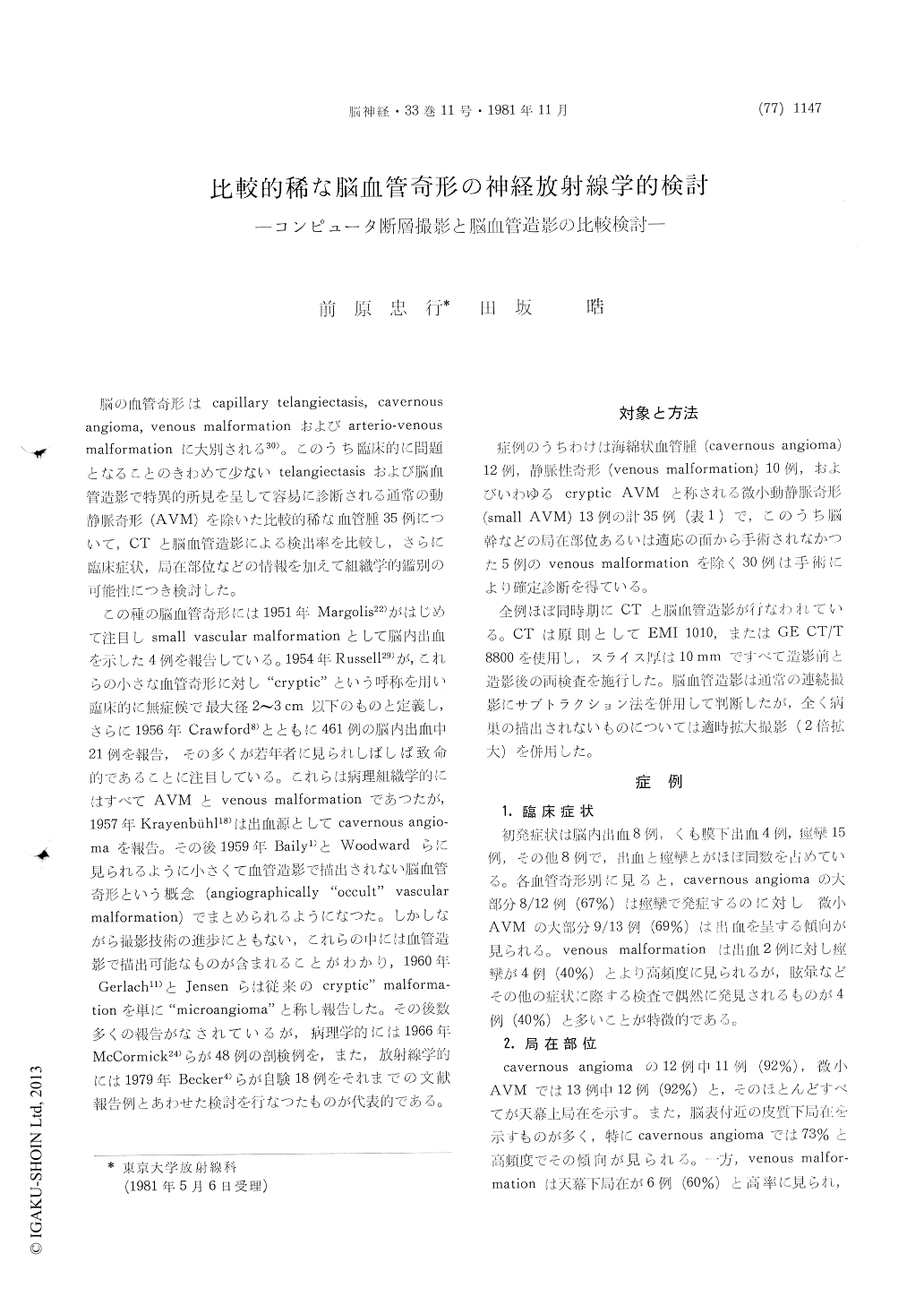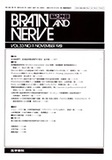Japanese
English
- 有料閲覧
- Abstract 文献概要
- 1ページ目 Look Inside
脳の血管奇形はcapillary telangiectasis,cavernousangioma,venous malformationおよびarterio-venousmalformationに大別される30)。このうち臨床的に問題となることのきわめて少ないtelangiectasisおよび脳血管造影で特異的所見を呈して容易に診断される通常の動静脈奇形(AVM)を除いた比較的稀な血管腫35例について,CTと脳血管造影による検出率を比較し,さらに臨床症状,局在部位などの情報を加えて組織学的鑑別の可能性につき検討した。
この種の脳血管奇形には1951年Margolis22)がはじめて注目しsmall vascular malformationとして脳内出血を示した4例を報告している。1954年Russel129)が,これらの小さな血管奇形に対し"cryptic"という呼称を用い臨床的に無症候で最大径2〜3cm以下のものと定義し,さらに1956年Crawford8)とともに461例の脳内出血中21例を報告,その多くが若年者に見られしばしば致命的であることに注目している。これらは病理組織学的にはすべてAVMとvenous malformationであつたが,1957年Krayenbuhl18)は出血源としてcavernous anglo—maを報告。その後1959年Baily1)とWoodwardらに見られるように小さくて血管造影で描出されない脳血管奇形という概念(angiographically"occult"vascularmalformation)でまとめられるようになつた。
Vascualr malformations of the brain are subdi-vided into capillary telangiectases, cavernous angiomas, venous malformations and arteriovenous malformations. The vast majority of these vascu-lar malformations are arteriovenous malformations and are easily diagnosed by angiography.
The purpose of this paper is to evaluate the diagnostic value of computed tomography and angiography in 35 cases of rare vascular malforma-tions. We are reporting 12 cases of cavernous angioma, 10 cases of venous malformation and 13 cases of small AVM. Capillary telangiectases are excluded from this study because of their little clinical importance.
All cases are examined by both CT and angio-graphy at almost the same time. It is very im-portant from therapeutic and prognostic point of view to get the correct pathological differentiation of these rare vascular malformations. Because almost all cases of small AVM (69%) cause intra-cerebral hemorrhage and cavernous angiomas usually show convulsion (67%) at onset and have potential curability by operation but may bleed later on. On the other hand, venous malformations are usually asymptomatic and are found out in-cidentally.
As to the anatomical location, 27 out of 35 cases (77%) are located supratentorially. Ninety-two per cent of cavernous angiomas and 92% of small AVMs show supratentorial location, and especially the former tends to show the subcortical location (73%). On the other hand, 60% of venous mal-formations are located infratentorially, especially in the cerebellum.
As these vascular malformations have been called "cryptic"or angiographically "occult"angioma, angiographic findings are not so obvious as in usual AVM. At first, detectability of the lesions is ex-amined. CT demonstrates the malformation itself in 31 out of 35 cases (89%) and in the other 4 cases, only associated hematomas are detected.
Twenty-two out of thirty-one cases (71%) show high density on pre-contrast CT and the others show isodensity. All cases show some contrast enhancement, so post-contrast CT is nessesary for detecting these vascular malformations. Ninety-one per cent of cavernous angiomas and 82% of small AVMs show nodular pattern in configuration, but 67% of venous malformations show linear pattern.
On the other hand, only 23 out of 35 cases (66%) are demonstrated by angiography. Ninety per cent of venous malformations and 69% of small AVMs are detected, but only 42% of cavernous angiomas are demonstrated by angiography. CT findings are not so specific but CT is the most accurate diagnostic method indicating the presence of the vascular malformations.
Neither CT nor angiography alone allows the specific identifications of the lesions, so a specific diagnosis of these vascular malformations can be obtained on the basis of the whole complex of the informations available, including CT, angiographic findings, clinical history and anatomical location.
Then possibility of the histopathological diagno-sis is evaluated and overall diagnostic ability is 89% by both CT and angiography together with clinical signs and information about anatomical location.

Copyright © 1981, Igaku-Shoin Ltd. All rights reserved.


